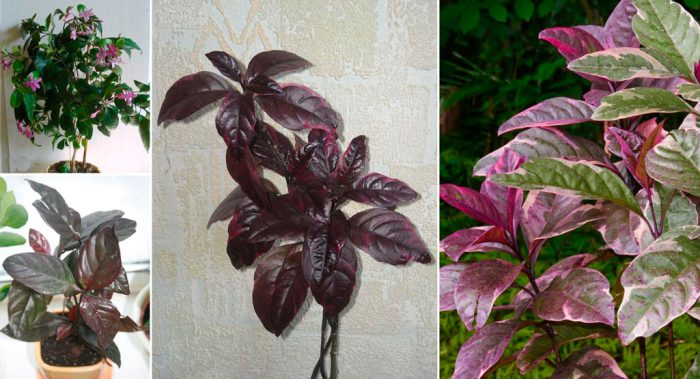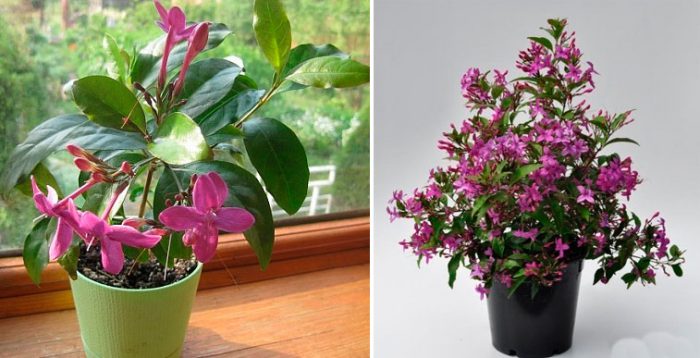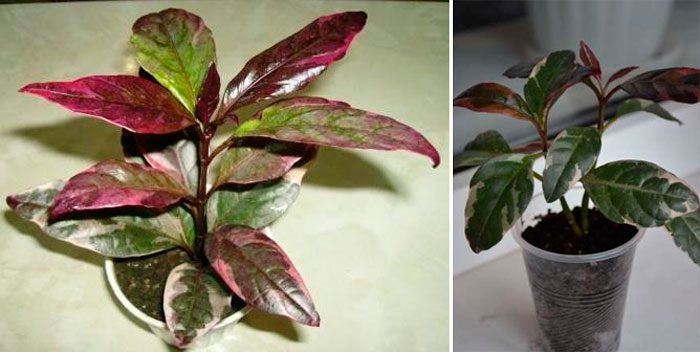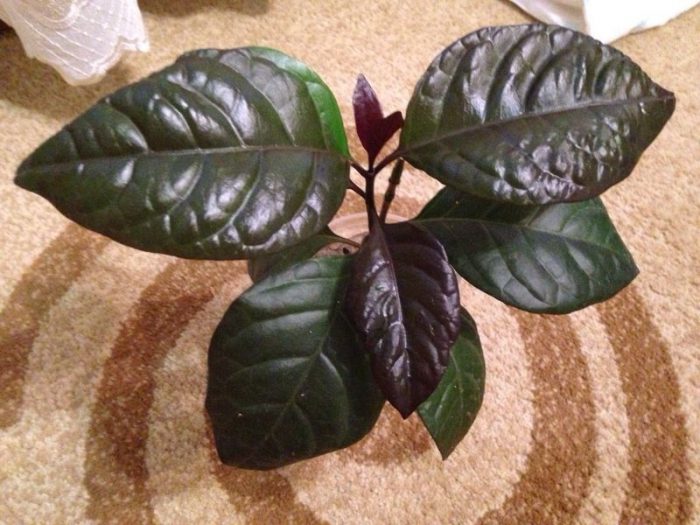A plant like pseudoerantemum belongs to the genus of flowering perennials of the acanthus family. This genus unites 120 species of various plants, among which there are both shrubs and shrubs, and herbaceous plants. They are found in tropical regions around the globe.
At home, only one species is grown, called Pseuderanthemum atropurpureum. In nature, it can be found in Polynesia. This shrub grows up to 120 centimeters in height. Its lateral stems stretch upward, and on them there are oppositely located short-petiolate leaves, which are large and elliptical or broadly ovate. The surface of the leaves is slightly bumpy and has a pronounced venation. Their edges are slightly wavy. In adult specimens, the leaf is 15 centimeters long and 10 centimeters wide. They are painted in an unusual pink-green color, as well as green-silver specks are located on their surface.
Small tubular pink-white flowers are collected in loose inflorescences, spike-shaped and located at the ends of the stems. It blooms for a very long time, but it should be borne in mind that when grown at home, flowering is a rare occurrence. In this regard, pseudoerantemum is grown as an ornamental leafy plant.
Content
Caring for pseudo-erantemum at home
This plant is not so easy to grow indoors, as it is very demanding and capricious to care for. As a rule, florariums or "tropical windows" are used for its cultivation. If this is not possible, then in this case it is necessary to study the rules of care presented below.
Illumination
Prefers bright, but diffused light. It is recommended to place it near windows of east or west orientation. The plant can also be placed near the south window, but you will need to shade it from direct sunlight.
In autumn and winter, he needs the same good lighting as in summer. Special phytolamps are used for illumination, and daylight hours for a pseudo-erantemum should last 12-14 hours.
If there is little light, the leaves will become faded and the spots will disappear. If the lighting is too intense, the leaves will turn very red, and the growth and development of the plant itself will stop.
Temperature regime
At any time of the year, the flower requires an equally moderate temperature of 20 to 25 degrees.If it gets colder, the plant will shed its foliage. When the temperature drops to 15 degrees and below, it may even die.
It reacts extremely negatively to sudden changes in temperature and drafts. You should not place a pseudo-erantemum near heating devices in winter, and you must be extremely careful to ventilate the room at this time.
How to water
This plant actively evaporates the moisture that it takes from the soil, in this regard, watering should be frequent and abundant. It is produced as the upper layer of the substrate dries up. For this purpose, exclusively settled and soft water, in which there is no chlorine, is used.
Water the flower carefully. So, a very slight overdrying of the soil can provoke a drop of foliage, and overflow will lead to the appearance of rot on the root system.
Humidity
You need high air humidity, especially in winter, when the air is dry by heating devices. To increase the humidity, pour a little pebbles or expanded clay into the pan, and then pour in water. It is also necessary to moisten the leaves from the sprayer at least 2 times a day, using soft, filtered or boiled water.
Pruning
Adult plants lose their decorative effect, because the leaves on the lower shoots fly around, and the branches become bare. In order to preserve the effective appearance of the pseudo-erantemum, it is necessary to regularly pinch the tops of the stems, which will form a more branched and fluffy crown.
You can also improve the decorativeness of the plant by changing the direction of the upright shoots. For this you need a lace. It is tied to a branch and folded down, and then the lace must be fixed. It can be removed only after the branch itself is fixed in the position you have chosen.
Earth mix
Suitable soil should be light, humus-rich, slightly acidic or neutral. To create a soil mixture, you need to combine leaf, peat and sod soil, as well as humus, which should be taken in equal shares, and then add a little vermiculite or coarse sand. Don't forget a good drainage layer.
Fertilizer
It is necessary to feed the plant relatively rarely, namely, once every 4 weeks in the spring-summer period. For feeding, it is best to use fertilizers with a high potassium content, because it gives the color of the foliage a richness. Try to add as little nitrogen as possible to the soil, because with an excess of it, the leaves can become monochromatic.
In the autumn-winter period, fertilizers are not applied to the soil.
Transplant features
This shrub grows very quickly and after a year another pot becomes very cramped for it. And this can provoke a drop of foliage. In this regard, the transplant should be annual. In this case, a pot of a larger diameter is taken than the previous one, and the root system must be slightly trimmed.
Reproduction methods
Propagation of pseudo-erantemum can be done quite simply and quickly by cuttings. To do this, cut off the top of a non-lignified shoot and root it in a simple glass of water or potting soil.
Pests and diseases
Can settle scabbards, worms, spider mites and whitefly... If pests are found, the plant must be given a hot shower, and then treated with a special chemical agent.














